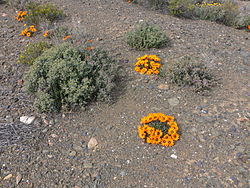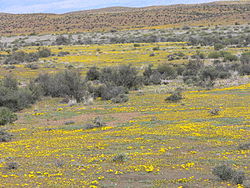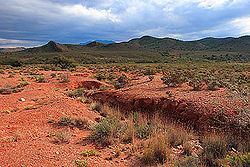
Karoo
Background Information
Arranging a Wikipedia selection for schools in the developing world without internet was an initiative by SOS Children. SOS mothers each look after a a family of sponsored children.

The Karoo (a Khoisan word of uncertain etymology ) is a semi-desert region of South Africa. It has two main sub-regions - the Great Karoo in the north and the Little Karoo in the south. The 'High' Karoo is one of the distinct physiographic provinces of the larger South African Platform division.
Great Karoo
The Great Karoo has an area of more than 400,000 square kilometers. From a geological point of view it has been a vast inland basin for most of the past 250 million years. At one stage the area was glaciated and the evidence for this is found in the widely-distributed Dwyka tillite. Later, at various times, there were great inland deltas, seas, lakes or swamps. Enormous deposits of coal formed and these are one of the pillars of the economy of South Africa today. Volcanic activity took place on a titanic scale. Despite this baptism of fire, ancient reptiles and amphibians prospered in the wet forests and their remains have made the Karoo famous amongst palaeontologists.
Western people first settled in the Cape in 1652 but made almost no inroads into the Karoo prior to about 1800. Before that time, large herds of antelope, zebra and other large game roamed the grassy flats of the region. The Khoi and Bushmen, last of the southern African Stone Age peoples, wandered far and wide. There were no Europeans and no Africans of Bantu extraction. (The area was never wet enough for cattle and this is probably the main reason why it was never occupied by the Bantu). The two ethnic groups mentioned above differed substantially in their cultures and lifestyles; the Hottentots were described as graziers of sheep and cattle, while the Bushmen were hunter-gatherers. (These were the original names given to these tribes by the Dutch. The terms may not be regarded as politically correct today). With the occupation of the region by European settlers, sheep gradually replaced the game and the cover of grass degenerated, owing to changes in the pattern of grazing and in the climate.
Starting in the middle years of the 19th century, a railway track was extended into the Karoo from Worcester in the south. This eventually extended its tendrils to Bechuanaland, South West Africa, Johannesburg, Rhodesia and far beyond. The impact of this railroad on the history of southern Africa is difficult to exaggerate.
During the Second Anglo-Boer War of 1899-1902, three Republican commando units, reinforced by the rebels from the Cape Colony, conducted widespread operations throughout the Karoo. Countless skirmishes took place in the region, with the Calvinia magisterial district, in particular, contributing a significant number of fighters to the Republican cause. Fought both conventionally and as a guerrilla struggle over the Karoo's vast expanses, it was a bloody war of attrition wherein both sides used newly developed technologies to their advantage. Numerous abandoned blockhouses can still be seen at strategic locations throughout the Great Karoo; a prime example is located next to the Geelbeks River, 12 kilometres outside the town of Laingsburg.
Currently sheep farming is still the economic backbone of the Karoo, with other forms of agriculture established in areas where irrigation is possible. Lately game farms and tourism have also started to make an economic impact.
- Karoo Gallery
Little Karoo
As the name implies, the Little Karoo is the smaller (and more southerly) of the two Karoo sub-regions. Locally it is usually called the Klein Karoo, which is Afrikaans for Little Karoo. Geographically it is a fertile valley (bounded on the north by the Swartberg, and on the south by the Langeberg and Outeniqua mountains). Although the boundaries of the region are not strictly defined, most people consider the western limit of the Little Karoo to be in the region of Barrydale and the eastern extremity around Uniondale.
The main town of the region is Oudtshoorn. Other towns/settlements in the region include Ladismith, Calitzdorp, De Rust,and well-known mission stations such as Zoar, Amalienstein, Barrydale and Dysselsdorp.
This area was first explored by European settlers in the late 17th century, who encountered only Khoisan people living in this rather dry area. Modern farming methods have brought productivity and wealth to this district.
Karoo in literature
The great English poet Thomas Hardy wrote in his poem The Dead Drummer:
Young Hodge the Drummer never knew -
Fresh from his Wessex home -
The meaning of the broad Karoo,
The Bush, the dusty loam,
And why uprose to nightly view
Strange stars amid the gloam.









